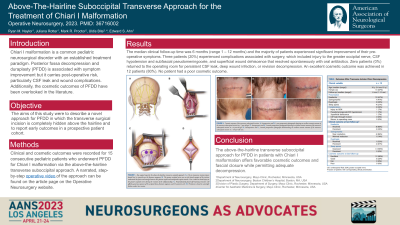Above-the-Hairline Suboccipital Transverse Approach for the Treatment of Chiari I Malformation
Above-The-Hairline Suboccipital Transverse Approach for the Treatment of Chiari I Malformation
Friday, April 21, 2023


Ryan Marcus Naylor, MD, PhD
Neurosurgery Resident
Mayo Clinic Rochester
Rochester, Minnesota, United States
ePoster Presenter(s)
Introduction: Chiari I malformation is a common pediatric neurosurgical disorder with an established treatment paradigm. Posterior fossa decompression and duraplasty (PFDD) is associated with symptom improvement but it carries post-operative risk, particularly CSF leak and wound complications. Additionally, the cosmetic outcomes of PFDD have been overlooked in the literature. The aims of this study were to describe a novel approach for PFDD in which the transverse surgical incision is completely hidden above the hairline and to report early outcomes in a prospective patient cohort.
Methods: A step-by-step description of the above-the-hairline transverse suboccipital approach is provided. Clinical and cosmetic outcomes were recorded for 15 consecutive pediatric patients who underwent PFDD for Chiari I malformation via the above-the-hairline transverse suboccipital approach.
Results: The median clinical follow-up time was 6 months (range 1 – 12 months) and the majority of patients experienced significant improvement of their pre-operative symptoms. Three patients (20%) experienced complications associated with surgery, which included injury to the greater occipital nerve, CSF hypotension and subfascial pseudomeningocele, and superficial wound dehiscence that resolved spontaneously with oral antibiotics. Zero patients (0%) returned to the operating room for persistent CSF leak, deep wound infection, or revision decompression. An excellent cosmetic outcome was achieved in 12 patients (80%). No patient had a poor cosmetic outcome.
Conclusion : The above-the-hairline transverse suboccipital approach for PFDD in patients with Chiari I malformation offers favorable cosmetic outcomes and fascial closure while permitting adequate decompression.
Methods: A step-by-step description of the above-the-hairline transverse suboccipital approach is provided. Clinical and cosmetic outcomes were recorded for 15 consecutive pediatric patients who underwent PFDD for Chiari I malformation via the above-the-hairline transverse suboccipital approach.
Results: The median clinical follow-up time was 6 months (range 1 – 12 months) and the majority of patients experienced significant improvement of their pre-operative symptoms. Three patients (20%) experienced complications associated with surgery, which included injury to the greater occipital nerve, CSF hypotension and subfascial pseudomeningocele, and superficial wound dehiscence that resolved spontaneously with oral antibiotics. Zero patients (0%) returned to the operating room for persistent CSF leak, deep wound infection, or revision decompression. An excellent cosmetic outcome was achieved in 12 patients (80%). No patient had a poor cosmetic outcome.
Conclusion : The above-the-hairline transverse suboccipital approach for PFDD in patients with Chiari I malformation offers favorable cosmetic outcomes and fascial closure while permitting adequate decompression.
